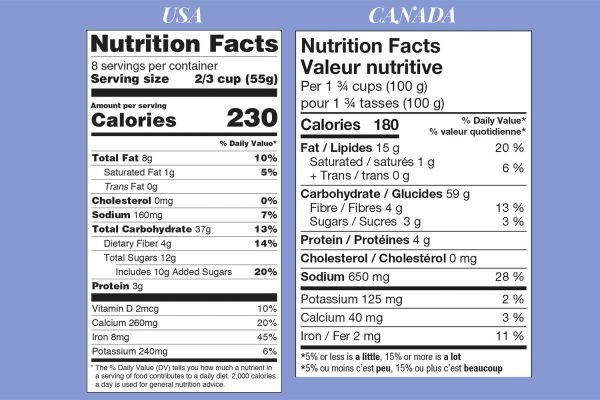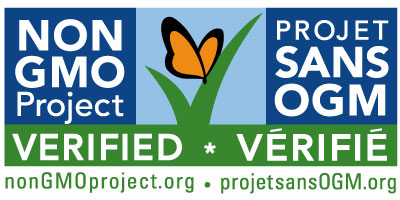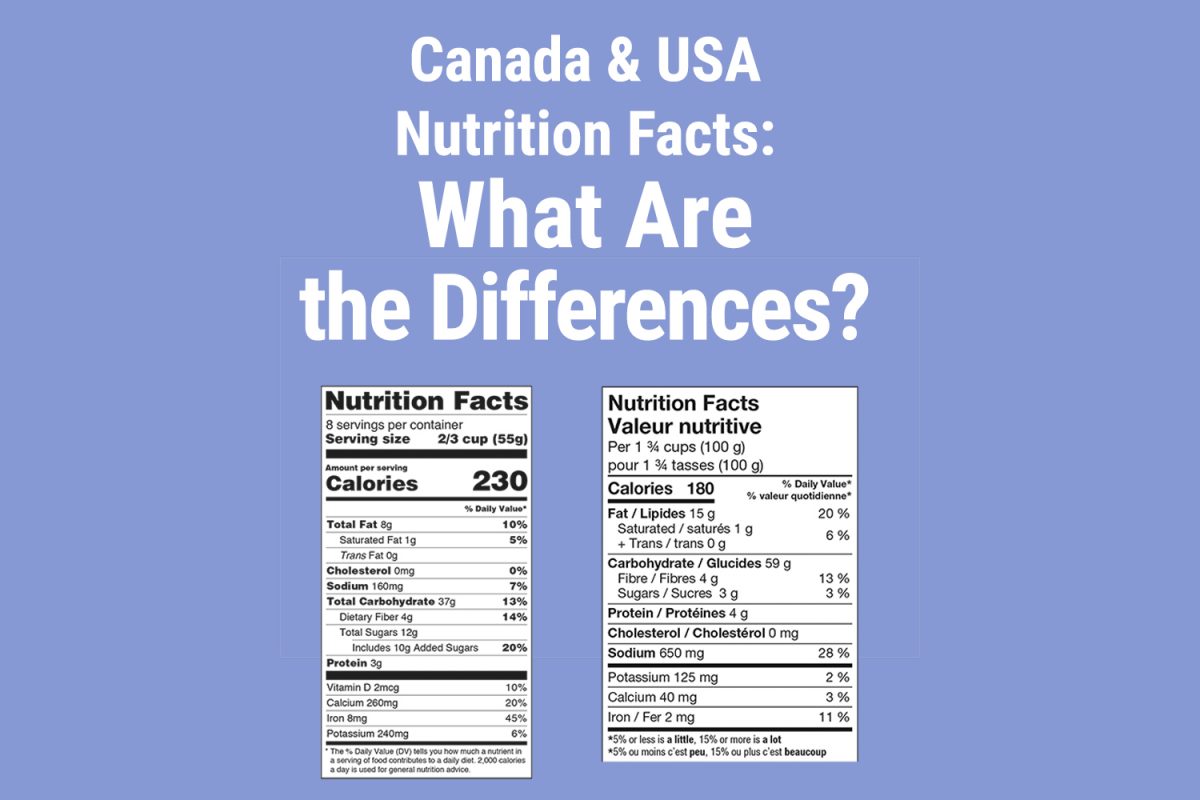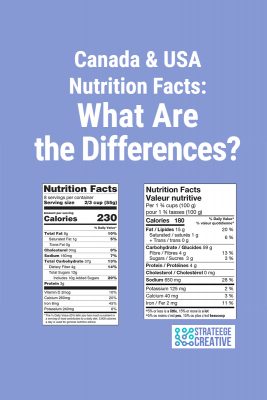In our first food labeling article (USA & Canada Food Labeling: 2016 New Regulations), we discussed the 2016 regulations changes to the U.S. and Canada nutrition tables. Let’s visit now the differences between U.S. and Canada food labels. It is an important topic because it could be tempting to believe that, as a U.S. food manufacturer, you can simply export your product to Canada. Well, you would be wrong: even though food labels seem to be more and more harmonized between the two countries, there are still some differences.
A. Nutrition Tables – Differences
-
Reference Daily Values
- As you know, Reference Daily Values for nutrients is the daily amount of a given nutrient recommended to intake per day. Note that you still find outdated documents online, even on the official FDA website. Make sure to check the date of the documentation you read. As described in our article, regulations changed in 2016.
- The table below shows the differences in daily values for adults:
| Daily Values | USA |
Canada |
| Fat | 78 g |
75 g |
-
Reference Amounts Customarily Consumed (RACCs) for serving sizes
Both countries have defined reference amounts for different categories of foods. These represent the amount of food typically consumed in one sitting. They are rather important as they serve to determine the serving size shown in the nutrition facts tables.
Importantly, they may be identical in Canada and the U.S., but they may be different.
Let’s mention a few examples:
| Reference Amount (RACC) | USA | Canada |
| Ice cream | ¾ cup | 2/3 cup |
| Yogurt | 175 g | 170 g |
| Cottage cheese | 110 g | 125 g |
| Sugar | 8 g | 4 g |
These are just some examples to highlight differences. Note that often, but not always, the U.S. RACC is higher. Many other products will have identical RACCs, for instance, cheese.
Also note that the RACCs are sometimes expressed in a different unit, for instance, “salad dressing,” expressed in mL in Canada and grams in the USA.
If you order your nutrition labels from a company, such as FoodLab for U.S. labels, they will use such RACCs to define the correct serving size for your nutrition table.
For the complete list of Reference Amounts Customarily Consumed (RACCs), visit:
- FDA’s CFR Title 21 – Reference amounts customarily consumed
- Health Canada – Table Reference Amounts for Food
-
Rounding values rules
Let’s quickly mention that when creating those nutrition tables, there are specific rules on the rounding of numbers for the weight of nutrients as well as the % of daily values.
-
Nutrition table layout and content
Let’s compare the two nutrition tables side-by-side:

- Unless you’re a local Canadian product outside Québec, your nutrition table must be bilingual (or you must have a separate table in each language),
- Font sizes are very different, in particular, the U.S. label emphasizes serving size and calories,
- The order of nutrients differs,
- Only the U.S. label lists the Daily Value % for cholesterol,
- The U.S. label specifies the amount of added sugars,
- The U.S. label includes Vitamin D,
- The explanatory text below the table differs.
B. Ingredients & Standards of Identity
As a U.S. manufacturer, it is important to understand that you may need to make some changes to your ingredients when importing to Canada. Each country has established “standards of identity” for a certain number of foods. These standards of identity define the ingredients’ characteristics.
For instance, the FDA has 300 identity standards in 20 categories of foods. And those standards can differ between Canada and the U.S.
Here are the links to the U.S. and the Canadian Standards of Identity:
For instance, in Canada, a “jam” must contain at least 45% of fruit, and cannot contain apple or rhubarb. In the USA, jam can contain apple or rhubarb. In Canada, enriched flour is required, i.e., contain a certain % of thiamine, riboflavin, niacin, folic acid, and iron per 100 grams of flour. “Bread” is a “yeast-leavened dough made of flour and water” with certain types of fat, gum, or yeast.
Some additives or coloring agents may be authorized in the U.S. and not in Canada, or vice-versa.
You’ll also need to know how you must name those ingredients, particularly additives.
Here are the links to the U.S. and Canadian lists of permitted additives:
Finally, you must check the authorized French translation for all your ingredients.
C. Allergens
If your packaging labeling doesn’t conform to the regulations, it may be the subject of a recall.
In that regard, it is crucial to list all the allergens which must be declared. Allergen declaration is one of the top reasons for recalls.
Be aware that the list of allergens with mandatory declaration is different in the U.S. and Canada.
Below is the list of allergens which must be declared in Canada (reference):
- almonds, Brazil nuts, cashews, hazelnuts, macadamia nuts, pecans, pine nuts, pistachios or walnuts;
- peanuts;
- sesame seeds;
- wheat or triticale;
- eggs;
- milk;
- soybeans;
- crustaceans
- shellfish;
- fish;
- Mustard seeds and powdered mustard
- Gluten from barley, oats, rye, triticale, and wheat
- Added sulphites (Canadian spelling)
Below is the list of allergens to declare in the USA (reference):
- Milk
- Eggs
- Fish (e.g., bass, flounder, cod)
- Crustacean shellfish (e.g., crab, lobster, shrimp)
- Tree nuts (e.g., almonds, walnuts, pecans)
- Peanuts
- Wheat
- Soybeans
Additionally, you must list gluten and sulfites on U.S. labels.
As you can see, Canada requires mustard seeds to be declared, whereas it is not an FDA requirement.
D. Health Claims
If you make any health claim on your packaging, you must make sure that these are acceptable in the other country when you decide to export.
Health claims include whole grains, organic, gluten-free, natural, non-GMO, etc.
Here are a few examples of things to consider:
- Make sure that your “grains” are “whole grains.” One of my clients’ products contained masa (a dough made from corn flour and used to make tortillas.) Regulators in Canada do not allow masa to count as a whole grain. So she had a “whole grain” claim on her U.S. packaging but could not have such a claim on her Canadian label. Another customer had a “whole grain” claim but used white rice. Again, she could not have such a claim in Canada.
-
 Check your organic claims with your USDA-Accredited Certifying Agent to confirm that you can be certified “organic” in Canada. Your USDA organic certification must be COR (Canadian Organic Regime) equivalent. “The U.S. has an “equivalency arrangement” with Canada. It means that as long as the terms of the equivalence arrangement are met, organic operations certified to the USDA organic regulations or Canada Organic Regime may be labeled and sold as organic in both countries”. The important words here are: “As long as the terms of the equivalence arrangement are met.” There are additional production requirements for U.S. products to be certified organic in Canada, and vice-versa.
Check your organic claims with your USDA-Accredited Certifying Agent to confirm that you can be certified “organic” in Canada. Your USDA organic certification must be COR (Canadian Organic Regime) equivalent. “The U.S. has an “equivalency arrangement” with Canada. It means that as long as the terms of the equivalence arrangement are met, organic operations certified to the USDA organic regulations or Canada Organic Regime may be labeled and sold as organic in both countries”. The important words here are: “As long as the terms of the equivalence arrangement are met.” There are additional production requirements for U.S. products to be certified organic in Canada, and vice-versa.
More information at International Trade Policies: Canada – US – Organic Standards.
Note that you can either use the USDA organic logo on your Canadian packaging or the Canadian organic logo. It seems that the USDA organic logo is more commonly used. There are also requirements regarding the mention of your certification body.  Understand the non-GMO regulations in both countries, as it requires specific wording on your labels, which is different in the U.S. and Canada. In particular, it is essential to understand the difference between genetically-modified and genetically-engineered.
Understand the non-GMO regulations in both countries, as it requires specific wording on your labels, which is different in the U.S. and Canada. In particular, it is essential to understand the difference between genetically-modified and genetically-engineered.
E. Net quantity statement
Net quantity is expressed differently in the U.S. and Canada.
F. Manufacturer’s or Distributor’s Information & Country of Origin
Canada and the U.S. also have specific instructions regarding the name and address information, as well as the country of origin.
G. “Best before,” “Package on” and Storage Information
That is another area with specific rules on the required information and how to phrase it. In Canada, these requirements are precise, including the way to write the dates. Note that requirements are different for products with a “life” of less than 90 days than for food with longer shelf life.
H. General Layout
There is indeed a long list of rules to follow on:
- the font size of various elements on the package,
- the location of the elements,
- the borders around information,
- the background color for ingredients and nutrition tables,
- the size of nutrition tables depending on the overall package size.
And some of those rules have recently changed. They would be too long to list here, but it highlights the importance of working with the right label specialist and graphic designer.
We have included several key reference documents here, to help you navigate the field of food labeling regulations in Canada and the U.S.
However, we have not discussed all the issues that you can face because each food product has its specificity. It’s a complex topic. Also, note that typographic rules are different in English and French. So hire a graphic designer who understands those differences!
Mandating your packaging and labels design to an agency with the knowledge in all the areas discussed here is not a bad idea.
Need some field research for your food products? Need American or Canadian-compliant food labels, compliant with the new 2016 regulations? Feel free to contact us. We can help.
Want to pin this article?


